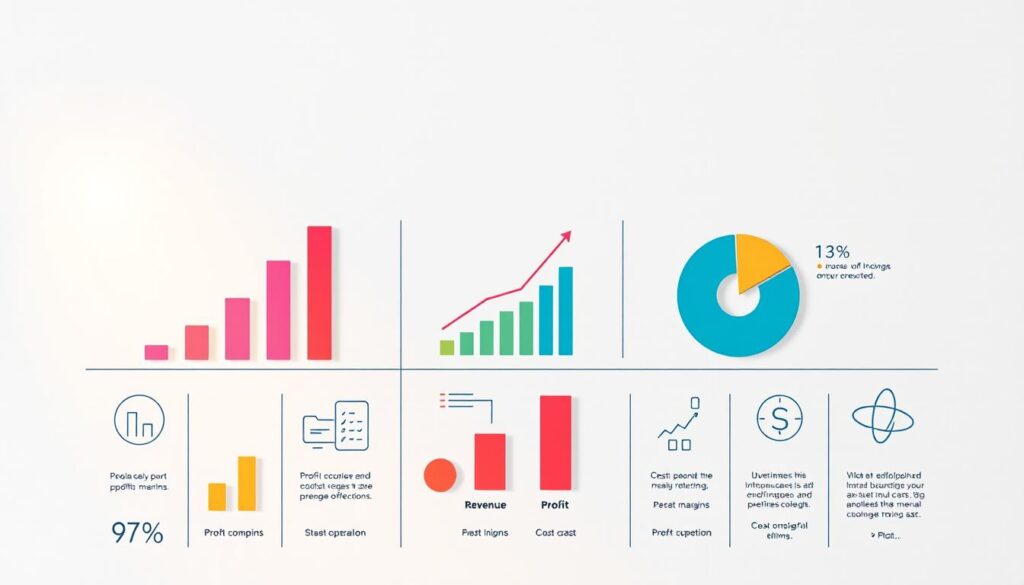Understanding profit margins and pricing strategies is key to boosting your business’s success. By getting the hang of these, you can greatly improve your financial standing. This article will dive into how pricing affects your profit margins and business health.
Learning these basics helps you make smart choices and plans. These actions can lead to your business growing financially.
Table of Contents
Key Takeaways
- Profit margins are vital for checking your business’s financial health.
- Pricing strategies are key to making your business more profitable.
- Knowing what customers value can shape your pricing.
- Regular price checks keep you ahead of the competition.
- Dynamic pricing adjusts to market and customer changes.
- Telling customers about price changes builds trust.
Introduction to Profit Margins
Profit margins are key to understanding a company’s financial health. They show how much of the revenue turns into profit. This knowledge helps in making better decisions.
Knowing these metrics is essential for spotting trends. It leads to changes that can help your business grow. This knowledge is vital for making smart choices and planning ahead.
Regularly checking profit margins is important for your business. It helps in growth and builds a culture of responsibility. This is good for the company’s health.
| Profit Margin Type | Calculation Method | Significance |
|---|---|---|
| Gross Profit Margin | (Revenue – Cost of Goods Sold) / Revenue x 100 | shows how well production and pricing work. |
| Operating Profit Margin | (Operating Income / Revenue) x 100 | shows how well the business runs and its expenses. |
| Net Profit Margin | (Net Income / Revenue) x 100 | shows the profit after all costs are covered. |
The Importance of Pricing Strategies
Pricing strategies are key in shaping how customers see your brand and where you stand in the market. The right price shows your value to customers, building trust in your brand. It’s more than just covering costs; it’s about meeting market demand and outsmarting competitors.
Good pricing strategies help you make more money by matching what customers want. Seeing how your prices stack up against others can give you an edge in keeping and attracting customers. This is vital for your business’s growth.
Knowing how to price in your industry boosts your market standing and keeps customers loyal. Pricing is not just about money; it’s a key part of running your business well. It drives your profits over time.
Understanding Profit Margins and Pricing Strategies
Knowing about profit margins is key for any business. It shows how well you make money from what you sell. It helps you see how good you are at managing costs and setting prices.
Definition and Significance of Profit Margins
Profit margins show how much of your sales is profit. They give you clues about your business. By watching these numbers, you can find what needs work and make better choices to increase profits.
Types of Profit Margins: Gross, Operating, and Net
There are three main profit margin types to think about:
- Gross Margin: This shows profit from main business activities after direct costs. It shows how well you price your products and run your operations.
- Operating Margin: This shows profit before interest and tax. It shows how well your business model works, including overhead costs.
- Net Margin: This is the final profit of your business, including all costs, taxes, and interest. It gives a full picture of your financial health.
Knowing these profit margin types helps you understand your finances better. By looking at each, you can spot what’s good and what’s not. This makes it easier to set good prices.
Key Concepts in Pricing
Understanding key pricing concepts is essential for your pricing strategies. Price elasticity and value perception are two important areas. They affect how customers behave and can greatly influence your business success.
Price Elasticity of Demand
Price elasticity shows how much customers react to price changes. Products with high elasticity see big demand changes with small price tweaks. For example, luxury goods sales drop when prices go up, while essentials stay steady.
It’s key to study your target market’s price sensitivities. This helps you set prices that boost revenue and meet customer needs.
Value Perception and Customer Behaviour
Perceived value greatly influences customer actions. It’s about how customers see the worth of a product or service. Quality, brand, and experience all play a part. High perceived value means customers are more likely to pay the price. Low value makes them price-sensitive and less likely to buy.
Knowing about value perception helps improve your products and pricing. Aligning prices with perceived value builds loyalty and satisfaction. It also guides better marketing and pricing choices.
Common Pricing Mistakes to Avoid
Pricing mistakes can hurt your business’s profits. It’s key to spot and fix these errors to keep profits up. Underpricing to get more customers can harm your finances over time. Companies that don’t value what customers think often lose loyalty and market standing.
It’s important to regularly check your pricing strategy. This helps you stay in line with market trends and keep up with competitors.
Underpricing to Attract Customers
Many businesses try to attract more customers by pricing low. This might bring in sales at first, but it can hurt your margins later. You might make your product seem less valuable to customers, which can cut into your profits.
Ignoring Customer Value Perceptions
It’s vital to understand what customers think about your product’s value. If you don’t, you might price it wrong. If customers think it’s overpriced, they might not buy it, even if it’s competitively priced.
Failure to Review Pricing Regularly
Don’t wait too long to review your pricing strategy. The market changes, and so do costs and competitor prices. If you don’t check your prices often, they might not match the market anymore. This can hurt your profit margins.
Proven Pricing Strategies for Profit Margin Growth
Effective pricing strategies are key to growing your profit margins. By using different methods, you can improve your market position and increase your earnings. This section looks at three important strategies: value-based pricing, tiered pricing models, and psychological pricing.
Value-Based Pricing
Value-based pricing sets prices based on what customers think your product is worth. You need to know what your customers value most. By pricing your product right, you make it more appealing to your market. This can lead to better sales and higher margins.
Tiered Pricing Models
Tiered pricing offers different prices for different customers. It helps those with varying budgets and needs. For example, a software company might have basic, intermediate, and premium plans.
This way, customers can pick what fits their budget and needs best. It can also increase the average order value while keeping customers happy.
Psychological Pricing Techniques
Psychological pricing uses tricks to influence buying decisions. Charm pricing, like £99.99 instead of £100, makes products seem more appealing. Other methods include limited-time offers and anchor pricing.
These strategies can boost impulse buys and make products seem more valuable. This can lead to higher margins.
How to Improve Your Profit Margins
To boost profit margins, focus on pricing and how you interact with customers. Use smart strategies to increase profits without hurting your brand’s image. Here are some important steps to take.
Regular Price Audits
Regular price checks are key to spotting underperforming products. They help you find items with low margins and decide if changes are needed. By looking at product prices against costs, you make choices that help increase profits.
Understanding Customer Segmentation
Segmenting customers well lets you set prices that match what they’re willing to pay. This approach not only boosts pricing but also makes customers happier. By pricing for different groups, you can make more money. Using metrics can help you understand customer behaviour better, as shown at this resource.
Minimising Discounting Practices
Reducing discounts keeps your products’ value high. Too many discounts can cut into profits and attract customers who only look for low prices. Instead, use discounts wisely to encourage sales that are good for your business and keep your prices stable.
Tools for Managing Pricing Strategy
In today’s fast-paced world, using the right tools for pricing is key to making more money. Businesses can make better pricing choices with pricing management tools. These tools help track the market, competitors, and what customers want. They help make decisions based on data and market trends.
Software Solutions for Pricing Optimisation
Investing in pricing optimisation software helps streamline your pricing. These tools use advanced analytics to find the best prices. They look at the market and what customers do, helping your business stay on top.
Using Data for Informed Pricing Decisions
Data is vital for good pricing strategies today. By using big data, companies can understand what customers like and what the market is doing. This knowledge helps set prices that attract customers and increase profits. Not using data can lead to missed chances and poor pricing.
| Tool Type | Description | Key Benefit |
|---|---|---|
| Pricing Analytics and Optimisation Tools | Analyse pricing data to understand trends and suggest optimal price points. | Improved price setting based on market insights. |
| CPQ Software | Streamlines the quote-to-cash process for B2B sales. | Increased efficiency in generating quotes and pricing. |
| Integrated Price Management | Centralizes pricing across various channels. | Consistency in pricing strategies globally. |
| Revenue Management Tools | Forecasts demand and sets prices to maximise revenue. | Optimised inventory management and pricing. |
| Trade Promotion Management Tools | Manages and tracks promotional activities. | Improved effectiveness of marketing campaigns. |
Dynamic Pricing and Market Adaptation
Dynamic pricing is key in today’s business world. It lets companies change prices quickly based on demand and what others are doing. This helps them stay on top of changes fast.
Real-Time Price Adjustments
Changing prices quickly is vital for making more money. Many businesses, like online shops and seasonal services, see big benefits. For example, adjusting prices for snow removal or holiday services can really boost profits.
Knowing how dynamic pricing works helps you make your strategy better.
Consumer Trends and Price Fluctuations
It’s important to keep an eye on what customers like and when. This helps you know when to change prices. By understanding what people buy and when, you can make your prices more appealing.
Knowing these trends and using smart promotions can increase sales, even during busy times. Seasonal businesses can do well by adapting quickly and making timely offers. For more seasonal business ideas, check out seasonal business ideas.
| Industry | Market Size | Key Seasonal Trend |
|---|---|---|
| Snow Removal Services | Over $20.5 billion | Winter Demand |
| Firewood Sales | Profitable with Delivery | Winter Season |
| Holidays Decor Services | £8.1 billion (2023) | Christmas Season |
| Lawn Care Services | High Demand (63% Homeowners Need Help) | Spring & Summer |
Effectively Communicating Price Changes
Telling your customers about price changes needs careful thought. It’s important to make them feel valued and in the loop. Being open about price changes helps build trust and loyalty. Explain why prices might go up, like because of higher costs or better quality.
For example, a local café might raise the price of lattes. They could say it’s because of the cost of ingredients. This way, customers understand and might even accept the change.
Strategies for Transparency with Customers
To be clear with your customers, try these tips:
- Be clear about why prices change, like because of ingredient costs or better quality.
- Give customers a heads-up before prices change, so they can adjust their plans.
- Use different ways to share the news, like emails, social media, and signs in the store.
- Ask for feedback and questions, showing you care about what they think.
Using these methods can help ease worries and make customers happier with changes. It makes it easier for them to accept and understand the need for these changes.
Timing Your Price Adjustments
When you change prices matters a lot. Keep an eye on what people are saying and the market to make sure changes fit well. For example, a family-owned furniture maker might raise prices before the busy season. This way, loyal customers are more likely to accept the change.
Choosing the right time for price changes can really affect how customers react. Keep up with market trends and seasonal changes to plan your adjustments wisely.
For more on making more money with smart pricing, check out this resource: effective pricing strategies.
Best Practices for Sustainable Profit Margins
To keep profit margins healthy, you need a strategic plan and ongoing improvement. By following the best practices for profit margins, your business can stay ahead in the market. It’s important to keep an eye on financial metrics and set clear profit margin goals to succeed.
Monitoring and Analysing Financial Metrics
Keeping an eye on financial metrics helps you spot trends and areas to focus on. By looking at costs, gross profit margins, and expenses, you can make smart choices. This way, you can improve your business’s financial health and stay competitive.
Setting Realistic Profit Margin Goals
Setting realistic profit margin goals is key for growth. Use industry standards and past data to set goals that are both challenging and reachable. This approach motivates your team and helps your business grow in the long run.
| Financial Metric | Current Value | Industry Benchmark | Goal |
|---|---|---|---|
| Gross Profit Margin | 30% | 35% | 32% |
| Operating Profit Margin | 15% | 18% | 16% |
| Net Profit Margin | 10% | 12% | 11% |
Conclusion
Mastering profit margins and pricing strategies is key to your business’s success. This article has given you a better understanding of how pricing affects profit and competition. By adjusting your prices wisely, you can boost your profit margins.
When dealing with pricing, watching your competitors is important. Use tools like a dropshipping markup calculator to find the best prices. This approach will increase your profits and strengthen your market position. Remember, growing sustainably means understanding profitability and adapting your pricing.
Stay updated with market changes to help your business grow. Improving your pricing strategies will greatly benefit your profits and competitive edge. For more on this, check out pricing strategies and profitability insights.
FAQ
What is a profit margin and why is it important?
A profit margin shows how much of your sales turn into profit. It’s key because it shows your company’s health, how well it runs, and how it manages costs. Knowing your profit margins helps you make better choices to increase profits.
How can I determine the appropriate pricing strategy for my business?
To find the right pricing, think about your target market, what your competitors charge, and what customers think your product is worth. Using pricing models like value-based or tiered pricing can help set prices that match different customer groups.
What are common mistakes businesses make with pricing?
Businesses often price too low to get more customers, which can hurt profits. They also ignore what customers think is a fair price. And they don’t update prices often enough to keep up with the market.
What tools can assist with pricing strategy optimisation?
Tools like pricing analytics software can give you important data. This data helps you understand the market, what competitors are doing, and how customers behave. This information helps you make smart pricing choices.
How does dynamic pricing work?
Dynamic pricing changes prices in real-time based on demand, what competitors do, and trends. It helps businesses stay competitive and make the most money by adjusting prices quickly.
What strategies can I use to communicate price changes effectively?
To share price changes clearly, explain why you’re changing them. Think about when you’re making the change to match customer feelings and market conditions. This builds trust and reduces complaints.
How often should I monitor and analyse my financial metrics?
Checking your financial numbers regularly is essential. It helps you spot trends, see how well your business runs, and adjust your pricing and margins. This keeps you competitive in the market.
What are the different types of profit margins?
There are several profit margins. Gross Profit Margin shows profit after direct costs. Operating Profit Margin shows earnings before tax from regular operations. Net Profit Margin shows total profit after all costs are covered.











